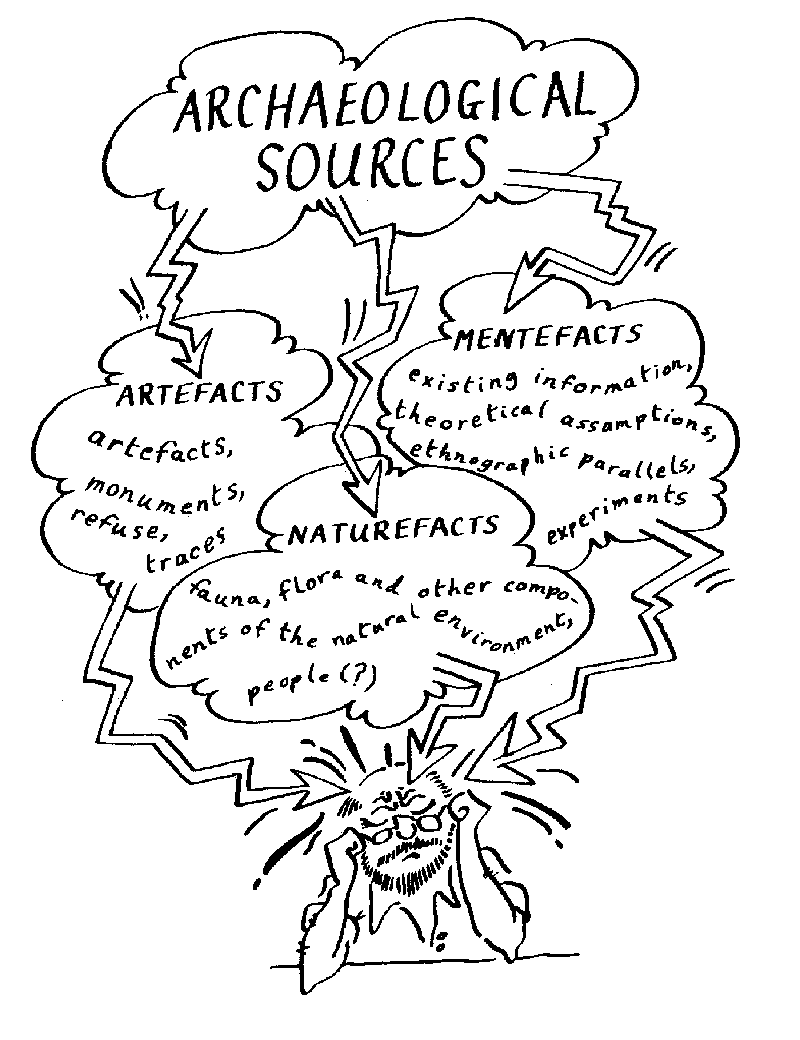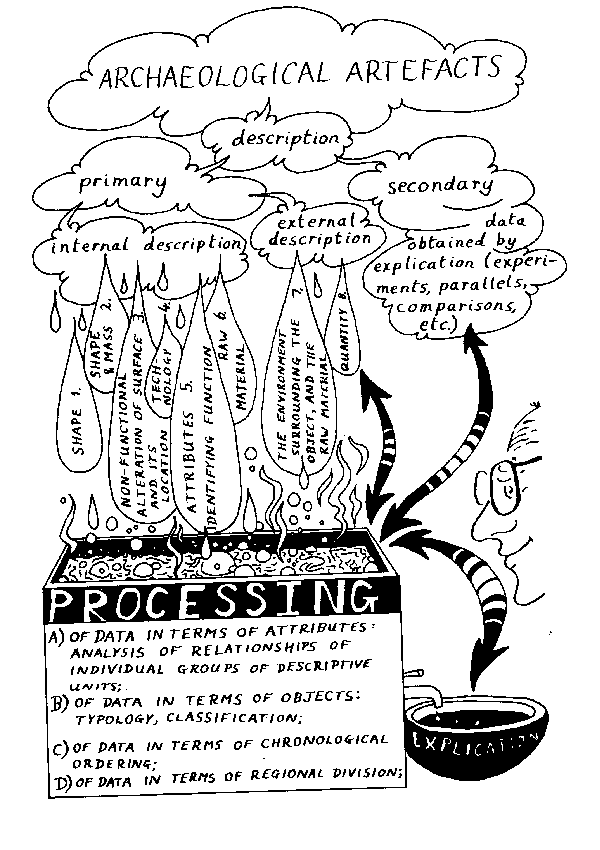

| The
Feature System Mapping the Site Stratigraphy |
Archaeology's history is a checkered one (Trigger 1989; Willey and Sabloff 1993). The first archaeologists were avocational explorers, diggers, and speculators. Some were fascinated by holding bits of the past. Others were driven by the desire to make money off of exotic treasures. This was the era of Indian Jones. Archaeologists were active fieldworkers, certainly better than theorizing anthropologists permanently glued to armchairs in upper class Victorian sitting rooms, but they were destructive collectors who intended to amass neat objects for display in museums.
By the middle 1900s, archaeologists began to try to preserve more information about the things they found. Elaborate strategies were designed for classification of things. Complete descriptions were the goal, and archaeology became more and more systematic, as well as more and more scientific in view and approach. This was the rise of the CULTURE-HISTORICAL SCHOOL of archaeology in the United States. Things were carefully excavated to standards of stratigraphic recording and reports emphasized the location and dating of things. Digs, often facilitated through Works Projects of America funding, were massive in scale. Entire sites were excavated and collections of things numbered in the hundreds of thousands.
Construction of local and regional chronologies was the goal, and distributions of objects in SPACE and TIME were held indicative of past societies and the movements of cultures and cultural ideas across the landscape (cf. Willey and Phillips 1958). Cultural TRAITS were defined that had demonstrated importance in defining the stringers of time and space, and these became the major rubrics for analysis and discussion of archaeological CULTURES. Emphasis was on description, CLASSIFICATION, and construction of narratives that explained the ARCHAEOLOGICAL RECORD in terms of alleged cultures that moved through space of time. Changes in traits became axiomatically associated with changes in basic elements of socioeconomic organization and earmarks of changing adaptive systems as well as labels for specific ethnic and linguistic groups in the past.
WHAM - BAM! CAME THE 60s! Old traditional culture history was bashed, mashed, chewed, and abused by the NEW ARCHAEOLOGISTS. These Mad Dog-, hell-bent-for-science PROCESSUALISTS would truck no more lengthy descriptions of stuff and tedious typological constructions (Binford 1962, 1964, 1965, 1968; Leone 1972; Watson et al. 1971). Their rallying cry was that there must be more to archaeology than a slavish adherence to the old kulturkreise school. Processualists would emphasize use of basic scientific method, with reliance on explicit HYPOTHESIS TESTING and characterization of human societies as ADAPTIVE SYSTEMS (e.g., Binford and Sabloff 1982; Clarke 1977; Flannery 1967, 1968, 1982; Hodder 1978). Culture-historical reconstructions were declared to be pseudo explanatory frameworks and definition of traits though useful for placing past societies in the basic framework of time and space could not be the declared end-products of archaeological research. CULTURAL CHRONOLOGIES were simply the beginning, serving as useful classificatory frameworks, in which more compelling questions of adaptation and CULTURAL CHANGE could be MODELED and addressed (cf. Clarke 1978; Sabloff 1981). The archaeological record was seen as archaeology's laboratory for studying HUMAN BEHAVIOR over the long expanse of time. Processual archaeology was firmly based in CULTURAL MATERIALISM in the mode of Leslie White and Marvin Harris, and asserted that the only suitable approach was to focus on the relationships between society and the physical environment. TECHNOLOGY was the principal means of human adaptation. SOCIAL ORGANIZATION facilitated the extraction of resources through use of technology. IDEOLOGY simply justified what had to be done to accomodate production (Harris 1968, 1979; White 1959, 1969, 1975). This view holds that cultures are inherently or overwhelmingly rational: CULTURE is defined as man's extrasomatic means of adaptation to his environment. Proponents asserted that archaeology was uniquely suited to establish patterns in how humans chose to adapt to their physical environments, and that archaeologists would contribute to knowledge of human behavior by identifying UNIVERSALS that would address behavior in terms of past-present-future.
In the early '80s a group of pragmatic archaeologists, leery of dooming culture-historical reconstructions to the trash heap and appalled by POSITIVIST materialist dogmas, advocated a HOLISTIC inspection of all facets of culture (technology, social organization, ideology) by archaeologists. These anthropologists were tagged as POST-PROCESSUALISTS (e.g., Hodder 1982, 1986, 1993; Shanks and Tilley 1987; Tilley 1990). This label actually encompasses a wide range of anthropological approaches that are grouped only when considered in contrast to the more narrowly defined materialist approach of the processualists. Post-Processualists emphasize study of patterns in material culture and insist that archaeologists can extract meaningful inferences about values, beliefs, religion, and social structure, as well as the more obvious socioeconomic or technological elements of human adaptation.
Archaeology for Post-Processualists is often defined as the anthropology of material culture, and encompasses but is not limited to Materialist positivistic approaches to study of past societies. Key words for Post-Processual approaches include material culture study, with key concepts being CONTEXT and CRITICAL THEORY. As the anthropology of things, Post-Processualist theory draws upon a vast array of anthropological theories, including Structuralism, Symbolic Anthropology, and tenets of Critical Marxism. Archaeology emerges in its P-P guise as a social anthropology of the past, not purely Western Science and not purely History, but a holistic study of humans in the past, including their institutions, their beliefs, and their culture in all its many facets.
Post-Processual approaches build on Culture History and on the New Archaeology of the Processualist school, but seek to broaden the field of study dramatically. P-p archaeologists are anthropologists who study material culture (Past-Present-Future). Under this definition, archaeologists no longer have to excavate sites. They might explore dumps, analyze gravestones, perform surveys of extant architecture, or canvas wearing apparel in shopping malls. P-P types dig though, and the analytical framework presented here addresses the tenets of the old school and applies method of the new.Terms
and Concepts
Archaeology as a discipline predicated on the analysis of a complex subject,
has evolved a jargon or lexicon all its own. In these cartoons, reproduced from
Malina and Vasicek (1990:Figs.3,4), the archaeologist attempts to sort out all
the myriad jargon terms that have become shorthand referents to theories and
concepts. All deal with what the archaeologist finds, and how the archaeologist
constructs inferences.
  |
| Figure 1. Cartoons showing the jargonized process of description and classification: a task not for the meek (from Malina and Vasicek 1990: Figs. 3 and 4). |
ARTIFACTS are things made, used, and modified by people. The term refers to tools, residues of tool manufacture, residues of processing plants and animals, and by-products of tool manufacture, processing, or other human activities.
NATUREFACTS are parts of plants or animals not modified by man, but indicative of man's physical environment. For example, seeds, plant parts or small animal remains found in an archaeological site can be analyzed to determine season of the year for man's occupation or indicate the climate and environment of a given period.
MENTEFACTS are the ideas and values that govern the creation of artifacts. Also called "mental templates" or "cognitive maps" or "cognitive frameworks," these structures are not beyond archaeological inference. Recognition of Mentefacts allows archaeologists to explore nonmaterial aspects of culture through analysis of the material manifestations of cultural needs and beliefs.How Do
We Get To Inference from Things?
These cartoons depict the inner recesses of the researcher's
mind: things found, categories applied, inferences drawn, facts elicited. Artifact
applies to the totality of the object or thing found. To find patterns indicative
of human behavior, and hence, culture, we must have a finer level of measurement:
the ATTRIBUTE. Attributes are measurements or observations drawn or about
artifacts. The attribute measured may be one zone of wear on a formed tool.
So, a given tool form may have dozens of measurable attributes. No description
is adequate without measurements taken at the attribute level of analysis. Attributes
may record basic morphology, alterations of surfaces, signposts of manufacture,
indicators of depositional environment, quantities or requencies, and any number
of other variable dimensions. Malina and Vasicek (1990), Neustupny (1993) and
Shennan (1988) offer excellent discussions of the need for rigorous measurement
frameworks in archaeological research (see also Clarke 1968, 1972 and 1977).
Inferences about past human behavior are constructed by correlating and cross-tabulating attribute lists. Our inferential patterns are then arranged in shifting hierarchies, with one form or focus simply being the level of measurement at which the pattern analysis is performed:
Gross: distribution of artifact types within the site.
Moderate: patterns of selected features observed on artifacts.
Fine: patterns defined by careful correlations of descriptive dimensions outlining attribute characteristics across tool types.
Very Fine: microscopic examination of working edges and working surfaces and physical and chemical examination of surfaces and residues, which result in pattern analysis performed on parts of a single artifact. Here, the artifact becomes directly analogous to the archaeological site.Binford, L.R.
1964 A consideration of archaeological research design. American Antiquity 29(4):425-451.
Binford, L.R.
1965 Archaeological systematics and the study of cultural process. American Antiquity 31(2):203-210.
Binford, L.R.
1968 Some comments on historical versus processual archaeology. Southwestern Journal of Anthropology 24(3):267-275.
Binford, L.R. and J.A. Sabloff
1982 Paradigms, systematics and archaeology. The Journal of Anthropological Research 38:137-153.
Clarke, D.L.
1968 Analytical Archaeology. London: Methuen.
Clarke, D.L.
1972 Models in Archaeology. ed. London: Methuen.
Clarke, D.L.
1977 Spatial Archaeology. London: Academic Press.
Flannery, K.V.
1967 Culture history vs. cultural process: A debate in American archaeology. Scientific American 217:119-122.
Flannery, K.V.
1968 Archaeological systems theory and early Mesoamerica. In Anthropological archaeology in the Americas, B.J. Meggers (ed.), pp.67-87. Washington, D.C.
Flannery, K.V.
1982 The Golden Marshalltown: A parable for the archaeology of the 1980s. American Anthropologist 84:265-278.
Gardin, J.-C. and C.S. Peebles (eds.)
1992 Representations in archaeology. Bloomington: Indiana University Press.
Harris, M.
1968 The rise of anthropological theory. New York: Crowell.
Harris, M.
1979 Cultural Materialism: The struggle for a science of culture. New York: Random House.
Hodder, I.
1978 Simulation studies in archaeology. ed. Cambridge: Cambridge University Press.
Hodder, I.
1982 Theoretical archaeology: A reactionary view. In Symbolic and structural anthropology, I. Hodder (ed.), pp.1-16. Cambridge: Cambridge University Press.
Hodder, I.
1986 Reading the past: Current approaches to interpretation in archaeology. Cambridge: Cambridge University Press.
Hodder, I.
1993 The narrative and rhetoric of material culture sequences. World Archaeology 25:268-282.
Leone, M.P. (ed.)
1971 Contemporary archaeology. Carbondale: Southern Illinois University Press.
Leone, M.P. and P.B. Potter (eds.)
1988 The recovery of meaning: Historical archaeology in the eastern United States. Washington, D.C.: Smithsonian Institution Press.
Malina, J. and Z. Vasicek
1990 Archaeology yesterday & today. Cambridge: Cambridge University Press.
Neustupny, E.
1993 Archaeological method. Cambridge: Cambridge University Press.
Renfrew, C. and E.B. Zubrow (eds.)
1994 The ancient mind: Elements of cognitive archaeology. Cambridge: Cambridge University Press.
Sabloff, J.A. (ed.)
1981 Simulations in archaeology. Albuquerque: University of New Mexico Press.
Shanks, M. and C. Tilley
1987 Reconstructing archaeology. Cambridge: Cambridge University Press.
Shennan, S.
1988 Quantifying archaeology. Edinburgh: Edinburgh University Press.
Tilley, C. (ed.)
1989 A history of archaeological thought. Cambridge: Cambridge University Press.
Tilley, C. (Ed.)
1990 Reading material culture. Cambridge: Cambridge University Press.
Watson, P.J., S.A. LeBlanc and C.L. Redman
1971 Explanation in archaeology, an explicitly scientific approach. New York: Columbia University Press.
White, L.A.
1949 The science of culture: A study of man and civilization. New York: Farrar and Strauss.
White, L.A.
1959 The evolution of culture. New York: McGraw-Hill.
White, L.A.
1975 The concept of cultural systems: A key to understanding tribes and nations. New York: Columbia University Press.
Willey, G.R. and P. Phillips
1958 Method and theory in American archaeology. Chicago The University of Chicago Press.
Willey, G.R. and J.A. Sabloff
1993 A history of American archaeology. New York: W.H. Freeman and Company.